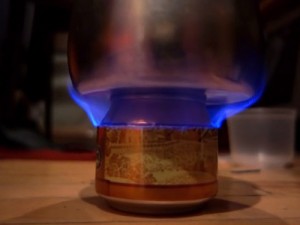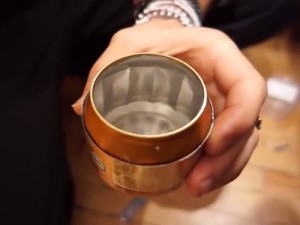 I’ve been making alcohol burners out of aluminum cans and tin cans for years, trying different combinations and modifications to make the best burner possible. One attempt was the “2 minute stove for $1” (although it lacked stability). A friend shared a link to a video titled “How to make the only travel stove you’ll ever need“. Kudos to Tom Allen and his friend who Published his video on Nov 27, 2013. It is by far my favorite design that requires a single can without the need for elaborate tools for construction.
I’ve been making alcohol burners out of aluminum cans and tin cans for years, trying different combinations and modifications to make the best burner possible. One attempt was the “2 minute stove for $1” (although it lacked stability). A friend shared a link to a video titled “How to make the only travel stove you’ll ever need“. Kudos to Tom Allen and his friend who Published his video on Nov 27, 2013. It is by far my favorite design that requires a single can without the need for elaborate tools for construction.
I’ve had a lot of fun making these at public events where I have demonstrated survival skills. I have an “Every Day Carry” (EDC) tool kit on a keyring that includes two items that I use to construct this burner: a P38 can opener and a small multi-tool scissors. As shown in the video it needs only a knife to accomplish the same task. In an urban scenario aluminum cans are an easy resource to find. With no need for drills or a secondary can this method is ideal for in-the-field construction.
 The inside walls of the burner are fluted, thus eliminating the need for small drilled holes like a conventional gas burner. They create channels for vaporized alcohol that naturally create the “holes” at the rim around the can. One single hole is made to relieve pressure/condensation caused when a pan is placed on top of the burner while cooking.
The inside walls of the burner are fluted, thus eliminating the need for small drilled holes like a conventional gas burner. They create channels for vaporized alcohol that naturally create the “holes” at the rim around the can. One single hole is made to relieve pressure/condensation caused when a pan is placed on top of the burner while cooking.
In my opinion denatured alcohol works the best as a fuel as it is completely consumed in the process whereas isopropyl (rubbing) alcohol contains water in it’s composition and can produce soot which increases as the concentration decreases. It comes in 90%, 75%, and 50% dilutions. Methyl and ethyl alcohols are also clean burning fuels. Denatured alcohol can be found in the painting section of a hardware store. The yellow “Heet” bottles of antifreeze gasoline additives contain ethyl alcohol and can be found at an automotive supply store. Acetone, an alternate fuel, can be found in the painting section of a hardware store, or, as most finger nail polish removers are composed of acetone, they can be found in most cosmetic departments of various stores.
I put this burner at the top of my list because it is cheap, easy to construct (it takes me about 5 minutes), easy to use, doesn’t need a primer lid, and is very reliable. Kudos to it’s inventors! I encourage you to make one for yourself so that you will have a burner on hand, and, so that you can show others how to make one for themselves.
(images taken from How to make the only travel stove you’ll ever need)


